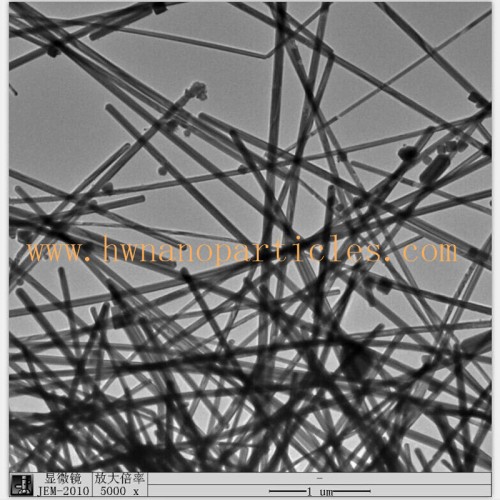One-dimensional nanomaterials refer to the size of one dimension of the material is between 1 and 100nm. Metal particles, when entering the nanoscale, will exhibit special effects that are different from those of macroscopic metals or single metal atoms, such as small size effects, interfaces, Effects, quantum size effects, macroscopic quantum tunneling effects, and dielectric confinement effects. Therefore, metal nanowires have great application potential in the fields of electricity, optics, thermals, magnetism and catalysis. Among them, silver nanowires are widely used in catalysts, surface-enhanced Raman scattering, and microelectronic devices because of their excellent electrical conductivity, heat conductivity, low surface resistance, high transparency, and good biocompatibility, thin film solar cells, micro-electrodes, and biosensors.
Silver nanowires applied in the catalytic field
Silver nanomaterials, especially silver nanomaterials with uniform size and high aspect ratio, have high catalytic properties. The researchers used PVP as a surface stabilizer and prepared silver nanowires by hydrothermal method and tested their electrocatalytic oxygen reduction reaction (ORR) properties by cyclic voltammetry. It was found that silver nanowires prepared without PVP were significantly The ORR’s current density is increased, showing stronger electrocatalytic ability. Another researcher used the polyol method to quickly and easily prepare silver nanowires and silver nanoparticles by regulating the amount of NaCl (indirect seed). By linear potential scanning method, it was found that silver nanowires and silver nanoparticles have different electrocatalytic activities for ORR under alkaline conditions, silver nanowires show better catalytic performance, and silver nanowires are electrocatalytic ORR Methanol has better resistance. Another researcher uses silver nanowires prepared by the polyol method as the catalytic electrode of a lithium oxide battery. As a result, it was found that silver nanowires having a high aspect ratio have a large reaction area and a strong oxygen reducing ability, and promoted the decomposition reaction of the lithium oxide battery below 3.4 V, resulting in a total electrical efficiency of 83.4%, showing the excellent electrocatalytic property.
Silver nanowires applied in the electrical field
Silver nanowires have gradually become the research focus of electrode materials due to their excellent electrical conductivity, low surface resistance and high transparency. Researchers prepared transparent silver nanowire electrodes with a smooth surface. In the experiment, the PVP film was used as a functional layer, and the surface of the silver nanowire film was covered by a mechanical transfer method, which effectively improved the surface roughness of the nanowire. The researchers prepared a flexible transparent conductive film with antibacterial properties. After the transparent conductive film was bent 1000 times (bending radius of 5mm), its surface resistance and light transmittance did not change significantly, and it can be widely applied to liquid crystal displays and wearables. Electronic devices and solar cells and many other fields. Another researcher uses 4 bismaleimide monomer (MDPB-FGEEDR) as a substrate to embed the transparent conductive polymer prepared from silver nanowires. The test found that after the conductive polymer was sheared by the external force, the notch was repaired under heating at 110°C, and 97% of the surface conductivity could be recovered within 5 minutes, and the same position could be repeatedly cut and repaired. Another researcher used silver nanowires and shape memory polymers (SMPs) to prepare a conductive polymer with a double-layer structure. The results show that the polymer has excellent flexibility and conductivity, can restore 80% of the deformation within 5s, and the voltage only 5V, even if the tensile deformation reaches 12% still maintain good conductivity, In addition, LED The turn-on potential is only 1.5V. The conductive polymer has great application potential in the field of wearable electronic devices in the future.
Silver nanowires applied in the field of optics
Silver nanowires have good electrical and thermal conductivity, and their own unique high transparency has been widely applied in optical devices, solar cells and electrode materials. The transparent silver nanowire electrode with smooth surface has good conductivity and the transmittance is up to 87.6%, which can be used as an alternative to organic light-emitting diodes and ITO materials in solar cells.
In the preparation of flexible transparent conductive film experiments, it’s explored that whether the number of silver nanowire deposition would influence the transparency. It was found that as the number of deposition cycles of silver nanowires increased to 1, 2, 3, and 4 times, the transparency of this transparent conductive film gradually decreased to 92%, 87.9%, 83.1%, and 80.4%, respectively.
In addition, silver nanowires can also be used as a surface-enhanced plasma carrier and are widely used in surface enhancing Raman spectroscopy (SERS) testing to achieve highly sensitive and nondestructive detection. The researchers used the constant potential method to prepare single crystal silver nanowire arrays with smooth surface and high aspect ratio in AAO templates.
Silver nanowires applied in the field of sensors
Silver nanowires are widely used in the field of sensors due to their good heat conductivity, electrical conductivity, biocompatibility and antibacterial properties. The researchers used silver nanowires and modified electrodes made of Pt as halide sensors to test the halogen elements in the solution system by cyclic voltammetry. The sensitivity was 0.059 in a 200 μmol/L~20.2 mmol/L Cl-solution. μA/(mmol•L), in the range of 0μmol/L~20.2mmol/L Br- and I-solutions, the sensitivities were 0.042μA/(mmol•L) and 0.032μA/(mmol•L) respectively. The researchers used a modified transparent carbon electrode made of silver nanowires and chitosan to monitor the As element in water with high sensitivity. Another researcher used silver nanowires prepared by the polyol method and modified the screen printed carbon electrode (SPCE) with an ultrasonic generator to prepare a non-enzymatic H2O2 sensor. The polarographic test showed that the sensor showed a stable current response in the range of 0.3 to 704.8 μmol/L H2O2, with a sensitivity of 6.626 μA/(μmol•cm2) and a response time of only 2 s. In addition, through current titration tests, it has been found that the sensor’s H2O2 recovery in human serum reaches 94.3%, further confirming that this non-enzymatic H2O2 sensor can be applied to the measurement of biological samples.
Media Contact
Company Name: Guangzhou Hongwu Material Technology Co., Ltd.
Email: Send Email
Phone: 17876573996
Country: China
Website: https://www.hwnanoparticles.com/

